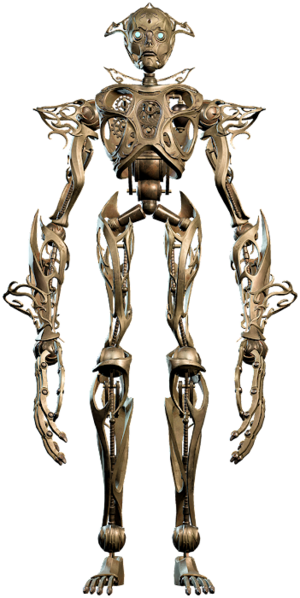⚠️ Please see plans to display ads on bg3.wiki. ⚠️
Construct
Constructs are a type of creature found within Baldur's Gate 3. They are mechanical and non-biological entities animated through magical or technological means. Constructs of various types are frequently encountered throughout the game and can even be summoned by the player with certain spells.
| “ | Creatures that are made instead of born. Some only follow a simple set of instructions, while others are imbued with sentience. |
„ |
Characteristics
Most constructs are assembled from inorganic matter. As such, many damage types that would normally be effective against organic creatures are ineffective against constructs. This includes ![]() Poison,
Poison, ![]() Psychic, and
Psychic, and ![]() Necrotic damage with most constructs possessing complete immunity to the first two types and resistance to the last one. Similarly, they are unaffected by many conditions such as , , or .
Necrotic damage with most constructs possessing complete immunity to the first two types and resistance to the last one. Similarly, they are unaffected by many conditions such as , , or .
Conversely, almost all healing effects including , , and have no effect on constructs. However, potions can still heal them.
Finally, as most constructs are not sentient, mental effects like or will have no effect on them.
Types of constructs
Adamantine Golem
- REDIRECT User:Template:ImageQuote
Adamantine golems are enormous, nearly indestructible golems constructed from pure adamantine. Nearly any attack against the solid adamantine structure of the golem will deflect harmlessly. To damage a golem, its adamantine structure must be softened first by it.
Adamantine golems in Baldur's Gate 3
Animated Armour
- REDIRECT User:Template:ImageQuote
Animated armours are minimally intelligent and capable of following only simple instructions from their creators. However, they are quite tough, as they consist of nothing but a suit of armour. This makes them ideal guardians and they can be encountered protecting long abandoned locations.
Animated armours in Baldur's Gate 3
Automaton
- REDIRECT User:Template:ImageQuote
Automatons are clockwork mechanical constructions designed to resemble humanoids.
Automatons in Baldur's Gate 3
Flesh Golem
- REDIRECT User:Template:ImageQuote
Flesh golems are assembled by stitching together disparate body parts from different corpses and then magically animating the result. Their construction blurs the line with necromancy, but flesh golems are distinct from undead.
Flesh golems in Baldur's Gate 3
Scrying Eye
- REDIRECT User:Template:ImageQuote
The leaders of the Cult of the Absolute frequently uses scrying eyes to monitor their underlings. They can be found patrolling Absolute outposts in the Shattered Sanctum, Grymforge, and Moonrise Towers. While they have no defensive capabilities of their own, they will alert nearby allies of any disturbance.
Scrying eyes in Baldur's Gate 3
Steel Watcher
- REDIRECT User:Template:ImageQuote
Steel Watchers are a fusion of mechanics, necromancy, and illithid psionics. They were designed by Enver Gortash and deployed to the streets of Baldur's Gate. There, they enforce Gortash's will and play a pivotal role in his power grab.
The design of the Steel Watchers was based on a Gondian design for an Auto-Guard, an exoskeleton intended to be piloted by a small individual. Instead of the living pilot, however, the armour is controlled by the decapitated body of a tadpoled zombie. The disembodied head maintains a psionic connection to the body thanks to the tadpole and can remotely puppet the Steel Watcher. In turn, the tadpoled brain is commanded by the Absolute.[text 1]
Steel Watchers in Baldur's Gate 3
Other
- Arcane Turret
- Doggy
- Elminster as a simulacrum
- Guardian of Faith
- Manifestation of Tyranny
- Nautiloid Cannon
- Spiritual Weapon
- Ptaris' Mental Image
 Stedd's Virtues of Unions,
Stedd's Virtues of Unions,  Amaps' Memoirs, and
Amaps' Memoirs, and  Suelto's Ethic of War as animated objects in Wyrmway.
Suelto's Ethic of War as animated objects in Wyrmway.
Related items
 Arrow of Construct Slaying - Consumable arrow that deals double damage against construct targets.
Arrow of Construct Slaying - Consumable arrow that deals double damage against construct targets. Summon Golem Bell - Summon the flesh golem Flesh while inside the Gauntlet of Shar.
Summon Golem Bell - Summon the flesh golem Flesh while inside the Gauntlet of Shar. Light of Creation - Non-construct wielders have a chance of being when attacking with this weapon.
Light of Creation - Non-construct wielders have a chance of being when attacking with this weapon. Gloves of the Automaton - After activating , the wearer is considered to be a construct for 10 turns.
Gloves of the Automaton - After activating , the wearer is considered to be a construct for 10 turns.
Notes
- does not affect constructs
 Sword of Life Stealing does not work against constructs
Sword of Life Stealing does not work against constructs Resonance Stone does not affect constructs
Resonance Stone does not affect constructs
